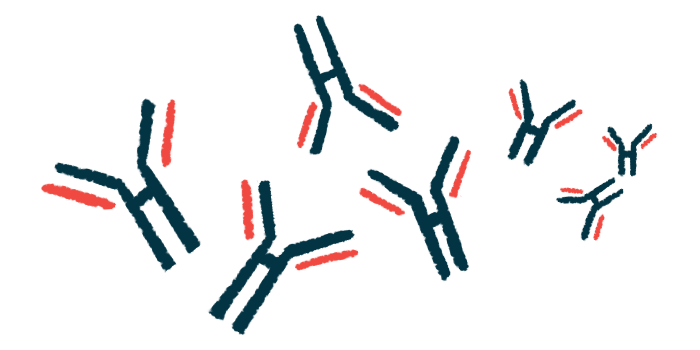2 self-reactive antibodies linked to higher relapse risk in AAV in study
Autoantibodies against HFE, SYT5 may be predictive biomarkers of relapse
Written by |

Self-reactive antibodies, or autoantibodies, against two proteins — homeostatic iron regulator, or HFE, and synaptotagmin 5, known as SYT5 — appear to be linked to a higher risk of relapse among people with ANCA-associated vasculitis (AAV), according to a new study.
These findings suggest that the presence of abnormal antibodies targeting either HFE or SYT5 may be used as potential predictive biomarkers of AAV relapse.
“Predicting which patients are more at risk of relapse is one of the major unmet needs in AAV clinical management, as it would help to modulate immunosuppression and [minimize] the risk of over/under-treatment,” the scientists wrote.
However, larger studies are needed to confirm the predictive potential of these self-reactive antibodies in AAV, the researchers noted.
The study, “Autoantibodies towards HFE and SYT5 in anti-neutrophil cytoplasm antibody-associated vasculitis relapse,” was published in the journal Rheumatology.
Looking for new biomarkers of higher relapse risk in AAV
Antibodies are proteins made by the immune system to combat infections. While these antibodies normally target parts of viruses or bacteria that can cause illness, in some instances, the immune system erroneously makes autoantibodies that target the body’s own tissue.
Autoantibodies are a major driver of autoimmune diseases. Most cases of AAV, an autoimmune condition marked by inflammation and damage to small blood vessels, are driven by autoantibodies called ANCAs.
However, AAV patients often are positive for other autoantibodies beyond ANCAs — though the role of these other self-targeting antibodies in the disease is unclear.
“Autoantibodies have already been reported as good candidate biomarkers for relapse prediction in other autoimmune diseases,” the researchers wrote.
To see if self-reactive antibodies other than ANCAs could help predict the risk of disease relapse in AAV, a team of scientists in Sweden and Ireland performed comprehensive analyses of autoantibody profiles in 246 AAV patients.
All patients were in remission at the time the blood samples were collected for autoantibody analysis.
The researchers first compared the autoantibody profiles of 26 patients — all of whom had been in remission for at least three years without the need for immunosuppressive treatments — against those of 71 who had experienced three or more relapses.
This analysis identified nine autoantibodies that were significantly more common in the frequent relapsers: More than half of those with frequent relapses (56%) were positive for at least one of these autoantibodies, compared with 15% of patients in long-term remission.
In addition, 21% of frequent relapsers tested positive for at least two of these autoantibodies, compared with none of those in long-term remission.
The researchers noted that the total number of autoantibodies was comparable between frequent relapsers and long-term remission patients. As such, the specific type of autoantibody seems to matter more than the total number, according to the team.
Researchers say this is first time these proteins have been ID’d
In a second analysis, the researchers analyzed autoantibody profiles from all 246 patients. Their goal was to identify the self-reactive antibodies detected significantly more frequently among those who ended up experiencing a relapse shortly after blood samples were collected.
This identified six autoantibodies associated with future relapse.
Importantly, according to the researchers, two different autoantibodies — one targeting the HFE protein and the other targeting the SYT5 protein — were identified in both the first and second analyses. Thus, the team hypothesized that these two autoantibodies were likely the most promising candidates for predicting relapse risk in AAV.
“To the best of our knowledge, neither of these proteins have been previously reported in connection to AAV or linked to relapse in AAV or other autoimmune diseases,” the team wrote.
HFE is present in most cell types, including neutrophils — the immune cells that become overly activated in AAV, ultimately triggering blood vessel inflammation and damage. It also plays a role in iron metabolism; problems with that process may cause anemia, a frequent complication in kidney disease and AAV.
SYT5 is particularly produced in brain cells, but is also present in the cells lining blood vessels, which are damaged in AVV.
To the best of our knowledge, neither of these proteins have been previously reported in connection to AAV or linked to relapse in AAV or other autoimmune diseases.
The team noted that further study will be needed to understand whether these autoantibodies play a role in the development or progression of AAV itself.
Also, “to confirm the association with relapse and [the] prediction potential of these two antibodies, independent and larger sample [groups] need to be analyzed,” the researchers wrote.
If future studies confirm the potential of these autoantibodies as markers of AAV relapse risk, it would be fairly straightforward to develop tests to detect these autoantibodies and predict relapse risk in clinical practice, the team noted.







